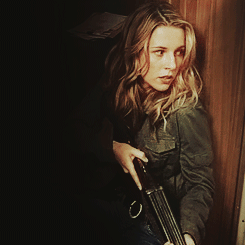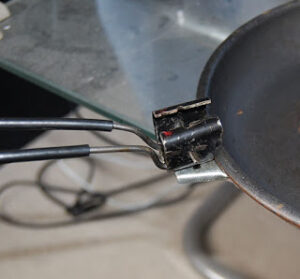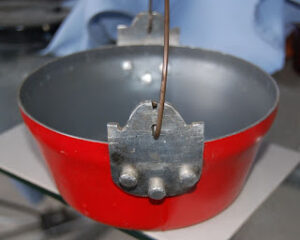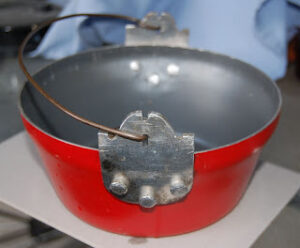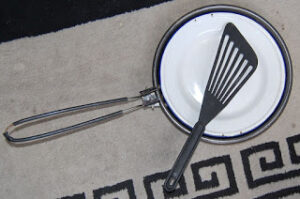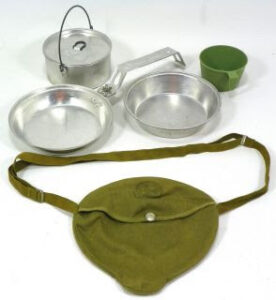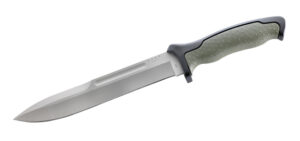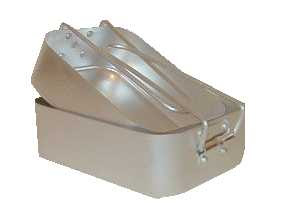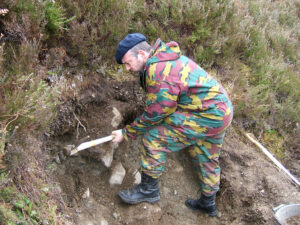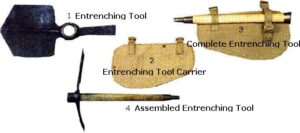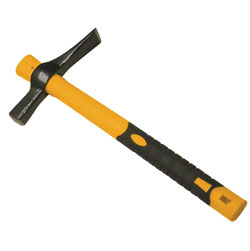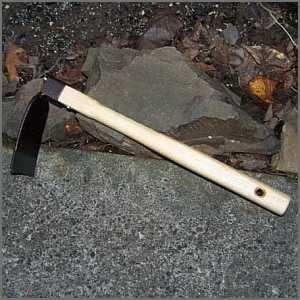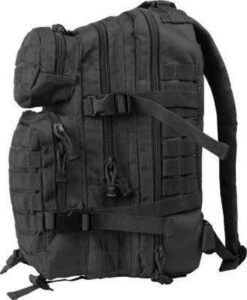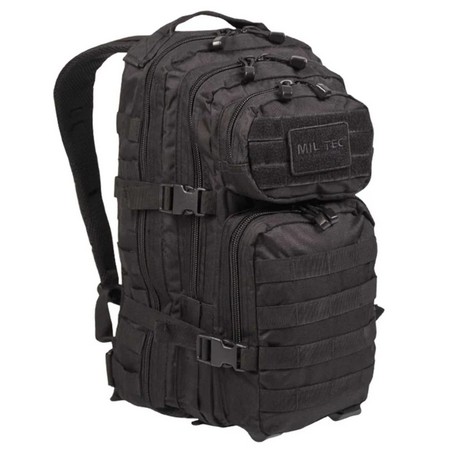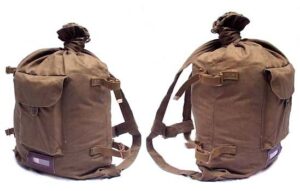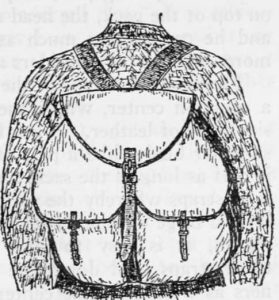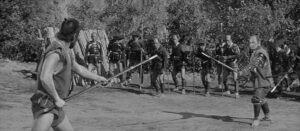In a recent post I mentioned "Camping and Woodcraft" by Horace Kephart. This is a book that has a lot to teach the modern outdoorsman.
In one chapter, Kephart reflects on the difficulty in designing an acceptable, effective cooking kit for just a single traveller.
The billies are carried in a bag, bottom to bottom so that no soot and fuel contaminated vessel nests within another. The interior of the billies are filled with bags of food such as flour and rice so effectively they occupy very little space.
Each billy has a lid to keep dirt and insects out and to retain heat. Each lid has a folding ring allowing the lid to be lifted with a stick, knife or other implement when they are hung over a fire.
The frying pan is a full sized utensil of 8 or 9" diameter. Kephart expects the traveller to bake his own breadstuff and one of the ways to do this is in the frying pan.
The pan also needs to be big enough to cook any game or fish that are caught.
The handle is either folding or detachable, and there is provision to attach an extension piece when cooking over a large bed of coals.
A tin cup and a deep plate or bowl for eating from complete the outfit.
If you choose wisely, the plate can fit in the stowed frying pan and even act as a lid when inverted.
Kephart’s suggestions seem logical but actually meeting these specifications proved to be more involved than I expected.
Most “camping billies” available on sale are nothing of the sort.
A true billy has a bail handle so it can be suspended above a heat source. This also allows it to be used as a bucket to fetch water.
The billies that you can find are generally much bigger than the one quart/two pint/one litre size suggested.
Camping frying pans, on the other hand, tend to be too small.
My own efforts to create a similar kit to Kephart's will be the subject of a later post.
Many people interested in survival or bushcraft tend to take their cues from the military.
When it comes to field cooking, the circumstances of the solitary traveller are rather different from those of a soldier.
For many armies the mess kit has cooking as only a secondary function. Meals are prepared by a field kitchen or catering unit, and the mess kit is mainly used to receive the finished product.
Since World War Two, the use of ration packs has become widespread and mess tins are mainly used for warming up the precooked items.
Modern soldiers make much less use of mess kits than previous generations.
Nowadays MREs are supplied with flameless cooking pouches, so many troops in the field do not carry any cooking equipment other than a canteen cup.
Larger field catering units often use disposable tableware instead.
The most basic military mess kit is probably the rectangular British Army “1937 pattern”. This has two rectangular cooking vessels, one slightly smaller than the other so they can nest. Capacity is approximately 1 litre and 1.3 litres (or 2 and 2 ½ pints).
On the plus side, the 37 pattern mess tins fit nicely in a pouch or side pocket of a pack. The SAS Survival Guide shows one used as a container for a variety of useful items in a “survival pouch”.
On the downside, the basic set has no lid. You can use the larger one as a lid for the smaller.
A number of companies make lids/plates for the larger pot. Some versions of lid have a sliding or folding handle, allowing the lid to be used as a small rectangular frying pan. They even offered a variant with a non-stick coating.
The 37 mess tins are not by any stretch of the imagination billies. They work well enough on many stoves but if you are cooking using natural fuels you will have to have a good bed of coals or get creative improvising a pot support.
The smaller one fits inside the larger so you will need to get the smaller very clean if you want to avoid contaminating your next meal with soot or fuel residue. That is not always possible out in the field. Placing the smaller in a bag to keep the larger clean is prudent.
For receiving a dollop of whatever from the field kitchen or heating water to warm ration tins, “boil in the bag” items, or make tea the 37 are adequate enough.
The British Army mess tins have been around a long time and are widely used. This has spawned useful accessories and variants such as lids and non-stick coated tins.
On the downside, there are sub-standard knock-off copies out there. Running out of clean cooking pots, I once used a mess tin to brown some flour on my kitchen stove. Liquid metal resembling solder appeared!
I have been told a genuine tin should have a bit of spring to it. If you push on the side with your thumb it should pop-back.
Other armies have taken different approaches to the same requirements.
The Germans, Russians and a number of other armies have issued a mess kit that looks a little like a binoculars case. In fact, as a boy I thought these items on my toy soldiers were packed field glasses!
The basic item has an oval or kidney-shaped cross section.
The bottom part is a deep pot, often provided with a bail handle. The lid is deep enough to also serve as a cooking vessel and provided with a folding side handle. It is neither pot nor frying pan really but makes a reasonable (if unconventionally shaped) cup.
Such mess kits formed a compact package that could be carried in a pack or pouch or attached directly to a belt or the outside of a knapsack.
Some versions have other components such as dishes or bowls that fit inside.
The German water canteen fitted inside a pair of aluminium cups of similar design to the mess kit.
To put these kits in context, they were often used in conjunction with field kitchens, and some soldiers of previous generations had more modest expectations when it came to food. If they got hot soup, coffee and fresh bread they considered themselves well off!
A small field kitchen such as the German horse-drawn models widely used in both wars had an oven and two big boiling vessels. One for coffee and the other for a hearty soup, stew or pasta dish.
A mess tin bottom full of soup and the lid filled with hot coffee was just what a fighting man wanted.
Two variants of this basic pattern are deserve a special mention.
The first is the Swedish Army Mess Kit.
This has an oval section billy for the bottom and a lid that also serves as a pan.
Lid capacity is about 550 mls, the lower section holds 1.3 litres.
The handle of the lid has two folding rings of an arch-shape. A stick can be inserted through these if you need a longer handle or one that will not conduct heat.
The Swedish Mess Kit comes with its own stove. This is a sturdy windshield that fits over the outside of the packed mess kit. Inside it at two folding pot supports and the kit also includes a spirit burner of similar design to that used on Trangia stoves.
The stove could also be used with other heat sources such as hexamine blocks, alcohol gel or natural fuel such as woodchips and pinecones.
The kit is completed by a plastic bottle marked with the Swedish triple crowns and the legend “RÖDSPRIT ELDFARLIG GIFTIG” (Methylated Spirit Inflammable Toxic). The bottle is of a size that it conveniently fits inside the mess kit but this practice is not recommended since leaks will contaminate your cooking vessels.
Keep your fuel bottle elsewhere and fill the interior of the mess kit with a brick of Supernoodles, some Oxo cubes, teabags etc.
I have used my Swedish Mess Kit several times. It is of a size and shape convenient to carry in a daysac.
If anything, it could be a little smaller. When you are hiking and the snow is on the ground it is been nice to stop and quickly heat up a quick hot snack of instant noodles.
The third kit I will discuss today is usually marketed as a Yugoslavian mess kit or “Eight piece” mess kit.
This differs from those of other armies in that the lower metal pot has a side handle rather than a bail.
The upper part is made from plastic so is more of a rectangular section bowl than a cooking vessel. The bowl is designed so that it slots onto a hook on the end of the handle, allowing both containers to be held in one hand.
Such arrangements are seen in a number of other mess kits and are intended to make handling the kit easier when queuing in a mess line.
The interior of the Yugoslav mess kit is used to store a plastic water bottle, which comes with its own rectangular beaker that fits over the top.
The final components are a carrying pouch and a metal knife, fork and spoon(KFS) set. The spoon and fork store in the handle of the knife. The knife also has a bottle opener cutout.
These Yugoslavian kits can be found at very reasonable prices. You only get one cooking vessel, but it is generously sized.
A detachable billy handle could probably be made by drilling holes near the rim at the point of balance.
I intend to acquire one of these kits soon so expect a more in depth review.
If nothing else the kits seems a good source of components that can be incorporated into a larger kit. Some camping KFS sets or water bottles cost more than this entire kit!
